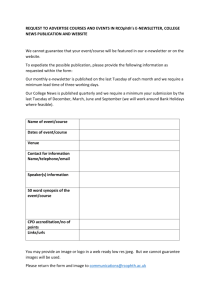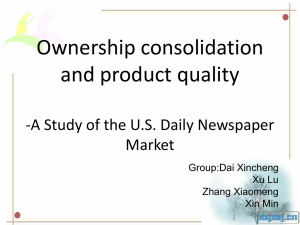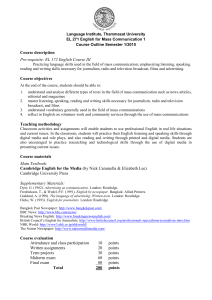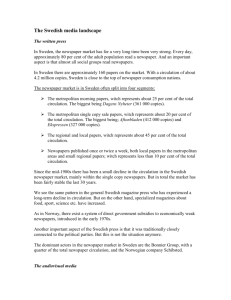Identifying media trends and advertising research for newspaper
advertisement
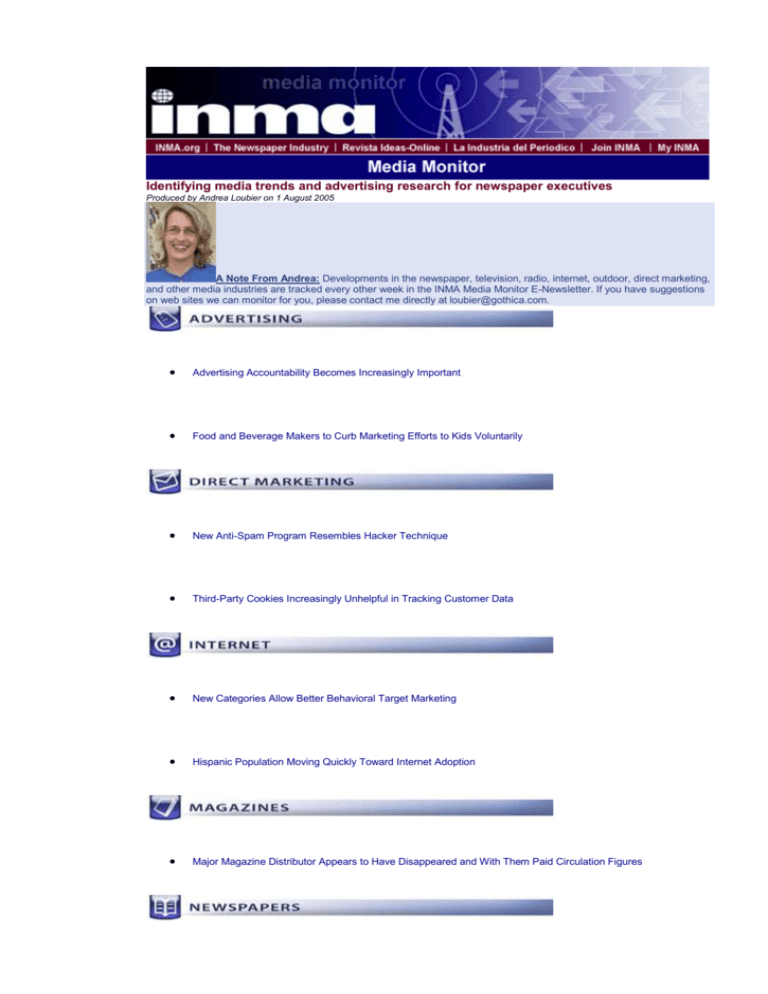
Identifying media trends and advertising research for newspaper executives Produced by Andrea Loubier on 1 August 2005 A Note From Andrea: Developments in the newspaper, television, radio, internet, outdoor, direct marketing, and other media industries are tracked every other week in the INMA Media Monitor E-Newsletter. If you have suggestions on web sites we can monitor for you, please contact me directly at loubier@gothica.com. Advertising Accountability Becomes Increasingly Important Food and Beverage Makers to Curb Marketing Efforts to Kids Voluntarily New Anti-Spam Program Resembles Hacker Technique Third-Party Cookies Increasingly Unhelpful in Tracking Customer Data New Categories Allow Better Behavioral Target Marketing Hispanic Population Moving Quickly Toward Internet Adoption Major Magazine Distributor Appears to Have Disappeared and With Them Paid Circulation Figures Quality Circulation on the Rise at Newspapers UK Regional Newspaper Seeking to Combine "Lite" and Main Edition Circulation Figures New York City's First-Ever Live Billboard Outdoor Media Company Fined ─10 Million in France New Radio Rating System From RAJAR Radio Needs to Improve Capture of Web Site Advertising Dollars Children Lose Interest in Television as They Age Click here to go back to the top of this e-newsletter Advertising Accountability Becomes Increasingly Important Source: The New York Times | 20 July 2005 The Association of National Advertisers, Marketing Management Analytics, and Forrester Research are releasing the results of a survey of advertisers and how they feel about advertising accountability. A telling statistic is that 61.5 percent of respondents felt it was important to them to define, measure, and take concrete steps in the area of advertising accountability, but only 19 percent said they were satisfied with their ability to do so. Even more surprising was that 73 percent felt they were not sure they understood the effect that an advertising or marketing campaign could have on sales. As marketing departments come under increasing scrutiny from bottom-line oriented management, they are clamoring for new and better tools to measure the return on their advertising investments. Food and Beverage Makers to Curb Marketing Efforts to Kids Voluntarily Source: Media Daily News | 14 July 2005 Amidst fears about ever increasing rates of childhood obesity ≈ and regulatory hearings at the Federal Trade Commission ≈ marketers of foods that kids eat have announce plans to self-regulate. The effort, called the Coalition for Healthy Children, is being organised by the Advertising Council, and is backed by several major food and beverage manufactures, as well as several health organizations. The effort will include several public service announcements about both nutrition and exercise for both children and parents, and will include methods for tracking their effectiveness. Related: Ban On Junk Food Ads To Kids May Sideline Entire Channels Click here to go back to the top of this e-newsletter New Anti-Spam Program Resembles Hacker Technique Source: Yahoo News | 22 July 2005 A new program from California-based Blue Security encourages multiple users to lodge complaints with web sites identified in spam automatically. If enough users lodge complaints at the same time, the web site can be shut down from traffic overload. Unfortunately this resembles a denial-of-service attack which is commonly used by hackers and virus creators. The company denies any wrongdoing in creating the program, but the Coalition Against Unsolicited Commercial E-mail has condemned the initiative saying it resembles a vigilante approach. Related: Anti-Spam Legislation Proves Ineffective in 2004 Third-Party Cookies Increasingly Unhelpful in Tracking Customer Data Source: ClickZ Networks | 20 July 2005 Coremetrics has recently released information that anonymous traffic totals 13.8 percent of traffic on retail Web sites using third-party cookies. This contrasts sharply with only 0.6 percent anonymous traffic for sites using first-party cookies. Other factors are prompting more and more retail sites to move to the first-party cookie system, include the increasing consumer use of anti-spyware software which routinely rejects third-party cookies as part of its protection. Related: Cookie Alternative May Revive Confidence in Web Analytics Click here to go back to the top of this e-newsletter New Categories Allow Better Behavioral Target Marketing Source: Daily Research News Online | 22 July 2005 New figures from 24/7 Real Media show that the number of advertisers using behavioural targeting increased by 147 percent over the last quarter of 2004. Click-through rates on adverts by these companies increased by 250 percent in the first quarter of 2005, compared with the last quarter of 2004. In an effort to further improve these numbers, 24/7 Real Media has added six new categories to its OnTarget service based on non-personally identifiable data it collects about internet habits. Related: The Next Wave in Online Advertising: Targeting by Context or Behaviour Hispanic Population Moving Quickly Toward Internet Adoption Source: ClickZ Networks | 19 July 2005 According to the third AOL/Roper U.S. Hispanic Cyberstudy, over the last 6 months Hispanic households have been adopting broadband at nearly twice the rate of the general population. This is significant for marketers for multiple reasons including that Hispanics view the internet as an opportunity to research and buy products and services as well as a means of advancement for their children. Some 47 percent of Hispanic households have children versus 37 percent of the general population. Related: Internet Usage Growth By Hispanics to Lead All U.S. Racial Groups Click here to go back to the top of this e-newsletter Major Magazine Distributor Appears to Have Disappeared and With Them Paid Circulation Figures Source: Newsday | 19 July 2005 The U.S. Audit Bureau of Circulations and BPA Worldwide, competing magazine circulation auditing firms, have announced that they will take a hard line toward circulation claims from publishers who used Inflight Newspapers & Magazines Inc. to distribute copies of their magazines to the airline industry. Inflight was recently sued by the Port Authority of New York and New Jersey and is being investigated by the federal government and appears to have closed its offices. In the wake of circulation scandals that have advertisers angry, the auditing firms have announced that paid circulation which cannot be proven will not be counted toward verified circulation figures. Related: Magazine to Use Two Circulation Audit Firms Click here to go back to the top of this e-newsletter Quality Circulation on the Rise at Newspapers Source: Editor & Publisher | 28 July 2005 In the wake of circulation scandals at several newspapers in the U.S., Prudential Equity Research has issued its second report on its analysis of Audit Bureau of Circulation figures for newspapers. The initial analysis was instigated to see if newspapers were reporting extra large numbers of papers distributed at hotels and to schools, both of which are considered to be lower-quality circulation. The second report found that distribution in these less desirable categories was up only 6.9 percent, versus a jump of 34.2 percent for the previous six month period. Therefore "quality" circulation is considered to be on the upswing at newspapers across the country, despite an overall drop in circulation of 2.7 percent. Related: Audit Bureau of Circulations To Tighten Audit Practices Related: Newspaper Circulation Up Worldwide, But Down in U.S., Europe UK Regional Newspaper Seeking to Combine "Lite" and Main Edition Circulation Figures Source: MediaWeek UK | 26 July 2005 While the "Lite" version of the Manchester Evening News, intended for afternoon commuters, has captured additional audience in the region, it has not made any significant difference in the circulation of the main edition of the newspaper. The newspaper is currently lobbying the Audit Bureau of Circulations for a change/clarification of its rules which would permit the paper to include the free daily's circulation in the Manchester Evening News' overall figures. Currently, advertisers get the Lite with any advertising they purchase which means better audience exposure for them, but the regional paper will reexamine that policy after the Lite version has been in circulation for 12 months. Click here to go back to the top of this e-newsletter New York City's First-Ever Live Billboard Source: Local6.com | 20 July 2005 A three-story display from the Calvin Klein Cosmetics Company counts as the first-ever live billboard. The advertisement is for a new fragrance and employs about 40 models who have been told to create the atmosphere of a 24-hour party. They're not to drink or engage in risque behaviour and they work in shifts throughout the day and night. The billboard also features music to promote the 'party' atmosphere. Related: Mobile Billboards Rise in Popularity Outdoor Media Company Fined ─10 Million in France Source: Forbes | 04 July 2005 JC Decaux SA is planning to appeal a ─10 million fine imposed on it by the French competition commission. The commission claims Decaux failed to meet conditions set in 1998 that were designed to prevent the advertising conglomerate from abusing its dominant position in the marketplace. JC Decaux feels that it has been compliant and notes that none of its competitors has filed a complaint since the restrictions were agreed to. Click here to go back to the top of this e-newsletter New Radio Rating System From RAJAR Source: MediaWeek UK | 12 July 2005 Rajar, the official radio measurement body in the UK has announced that it will open up bidding for its radio ratings contract. The new system will measure radio listenership across traditional and digital radio, including that broadcast over digital television, as well as internet broadcasts. The system will likely contain an electronic monitoring component in addition to the current diary method. It promises to give a much more comprehensive and accurate representation of radio listenership. Related: Radio Company Loses Suit Against Audience Rating Company Over Failure to Implement Electronic Measuring Radio Needs to Improve Capture of Web Site Advertising Dollars Source: Billboard Radio Monitor | 21 July 2005 Web sites for traditional media like newspapers, television, and radio represent an increasing source of advertising revenue for those media. However, radio needs to improve the way it leverages its web sites. Radio web sites capture only 2 percent of the U.S.$3.9 billion that local advertisers spend on internet advertising, while newspaper web sites garner 39 percent. Experts suggested that radio stations include a web component in every advertising proposal and that they hire more people to promote and sell their internet advertising space. And web sites should be re-tooled to become a news source for its listeners so they have a reason to come back often and give their e-mail address. Related: Newspaper Web Sites Top TV Web Sites for Local Advertising Click here to go back to the top of this e-newsletter Children Lose Interest in Television as They Age Source: Media Daily News | 31 July 2005 New television research shows that as the 8- to 12-year-old television watching segment gets older it tends to watch less television. While 80 percent of the so-called "tweens" say they "love" television, that number drops to 60 percent when they reach ages 12 to 14. Other activities, such as listening to music, reading, and surfing the internet distract them from television watching. Industry experts say moving that advertising money to the internet would help them stay connected with the demographic. Click here to go back to the top of this e-newsletter About This E-Newsletter: Media Monitor is a bi-weekly e-newsletter produced by the International Newspaper Marketing Association (INMA) for executives interested in what various media industries are doing to represent themselves to advertisers and publics. Particular emphasis of this e-newsletter is on advertising effectiveness of various media. Subscribers to this e-newsletter may view the complete Media Monitor archive 24/7 by clicking here. The e-newsletter is free to INMA members and available for US$50 per half year for non-members. To unsubscribe to this e-newsletter, go to your "My INMA" page by clicking here. Andrea Loubier, a Dallas-based freelance author and former membership manager of INMA, produces the Media Monitor based on her monitoring of 50+ web sites and trade magazines.
